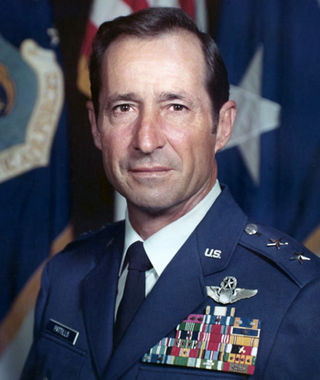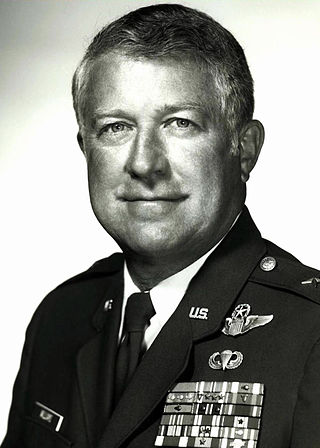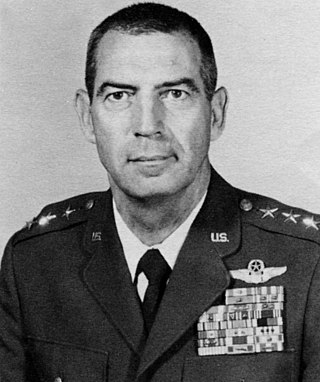
General John Charles Meyer was an American World War II flying ace, and later the commander-in-chief of the Strategic Air Command (SAC) and director of the Joint Strategic Target Planning Staff at Offutt Air Force Base, Nebraska. SAC was the United States' major nuclear deterrent force with bombers, tankers and reconnaissance aircraft, and intercontinental ballistic missiles. The Joint Strategic Target Planning Staff coordinated the nation's nuclear war plans and developed the Single Integrated Operations Plan.

George Brenner Simler was a United States Air Force general, who served as commander of the U.S. Air Force's Air Training Command.

Robert E. Kelley was a United States Air Force lieutenant general, the ninth Superintendent of the U.S. Air Force Academy. He retired as a lieutenant general on September 1, 1986.

Carlos Maurice Talbott was a United States Air Force officer who attained the rank of lieutenant general and was vice commander in chief of the Pacific Air Forces, headquartered at Hickam Air Force Base.

Jimmie Vick Adams is a retired four-star general in the United States Air Force (USAF). He served as commander in chief, Pacific Air Forces (CINCPACAF) from 1991 to 1993.

Ernest Thorpe Cragg was a major general in the United States Air Force.

Kenneth Walter North was a brigadier general in the United States Air Force as well as a prisoner of war during the Vietnam War. After his release, he commanded various units and was eventually promoted to general in 1982.

Robert Dale Russ was a United States Air Force (USAF) general and commander of Tactical Air Command.

Jack Irvin Gregory is a former general in the United States Air Force and the former commander in chief of the Pacific Air Forces.

James Montgomery Breedlove was an American air force major general who was commander, U.S. Air Force Southern Air Division of the Tactical Air Command and deputy commander in chief, United States Southern Command, Quarry Heights, Canal Zone.

Walter Turbush Galligan was a United States Air Force lieutenant general who served as commander United States Forces Japan and Fifth Air Force, with headquarters at Yokota Air Base, Japan. As commander, he was the senior United States military representative in Japan and responsible for the conduct of United States air operations in Japan and the Republic of Korea.

Charles Curtis Pattillo, also known as Buck Pattillo, was an American Air Force lieutenant general who was deputy commander in chief, U.S. Readiness Command and vice director of the Joint Deployment Agency with headquarters at MacDill Air Force Base, Florida. He died in May 2019 at the age of 94.

Arthur Columbus Agan Jr. was an American Air Force lieutenant general who was commander of the United States Air Force Aerospace Defense Command with headquarters at Ent Air Force Base, Colorado.

Lynwood Edgerton Clark is an American former Air Force lieutenant general who was commander of the Alaskan Air Command, with additional duty as commander of Alaskan North American Aerospace Defense Region, Elmendorf Air Force Base, Alaska. The mission of the Alaskan Air Command is to provide top cover for America and air support in the defense of Alaska.

Freddie Lee Poston was an American lieutenant general who was chief of staff at United States Pacific Command, Camp H. M. Smith, Hawaii. Poston is responsible to the commander in chief Pacific for management of key military staff activities requiring coordinated Air Force, Navy, Army and Marine Corps operations throughout the Pacific Command. The Pacific Command is the United States' largest unified command, encompassing some 100 million square miles from the West Coast of the Americas to the east coast of Africa and from the arctic to the Antarctic.

Joseph Harold Moore was a lieutenant general in the United States Air Force (USAF), known for his role as commander of the 2nd Air Division and Seventh Air Force during part the Vietnam War, and in particular, his leadership role in Operation Rolling Thunder.

Gordon E. Williams is a retired United States Air Force officer. A command pilot with more than 4,000 flying hours, he flew numerous Air Force and Navy aircraft. Upon his retirement on 1 August 1988, he was the director for plans and policy, J-5, Headquarters United States European Command, Stuttgart-Vaihingen, West Germany.

James Robert Brown was a lieutenant general in the United States Air Force who served as vice commander of Tactical Air Command, with headquarters at Langley Air Force Base, Virginia. The command comprises more than 118,000 military and civilian personnel, stationed at 18 major Tactical Air Command installations and other units in the United States, Panama, Okinawa and Iceland. Tactical Air Command was the operational combat organization for 74,000 Air National Guard and Air Force Reserve personnel throughout the United States.

Craven C. Rogers Jr. was a lieutenant general in the United States Air Force who served as deputy commander in chief of the U.S. Central Command at MacDill Air Force Base, Florida. The command was tasked with achieving United States national objectives in Southwest Asia, the Persian Gulf, and the Horn of Africa. Rogers was born in 1934, in Galveston, Texas. He earned a Bachelor of Science degree in engineering from the U.S. Military Academy in 1957 and a master's degree in business administration from The George Washington University. He completed Squadron Officer School in 1962 and the Industrial College of the Armed Forces in 1973. Upon graduation from the academy he was commissioned as a second lieutenant in the Air Force. After completing pilot training in September 1958 he was assigned to Tactical Air Command at Williams Air Force Base, Ariz., for gunnery training in the F-86F. With the phaseout of the F-86F, Rogers transferred in June 1959 as an instructor pilot to Air Training Command, Vance Air Force Base, Oklahoma. He completed F-101A transition training in September 1964 and then was assigned as a tactical fighter pilot with the 91st Tactical Fighter Squadron, Royal Air Force Station Bentwaters, England. In 1965 his squadron became the first unit in the United States Air Forces in Europe to transition to the F-4. Rogers assumed duties in the Standardization and Evaluation Section of the 81st Tactical Fighter Wing at Bentwaters in November 1966. In September 1967 he transferred to Nellis Air Force Base, Nevada, where he completed the F-4 Fighter Weapons School. In January 1968 he was assigned to the 557th Tactical Fighter Squadron, 12th Tactical Fighter Wing, Cam Ranh Bay Air Base, South Vietnam, as a flight commander and squadron weapons officer. He subsequently served as the wing weapons officer and assistant chief of weapons and tactics for 12th Tactical Fighter Wing. He flew 255 combat missions and 435 combat flying hours in the F-4C. He returned from Southeast Asia in February 1969 and was assigned to the Fighter and Reconnaissance Manning Section, Air Force Military Personnel Center, Randolph Air Force Base, Texas. He became chief of the section in 1971. Upon graduation from the Industrial College of the Armed Forces in August 1973, Rogers became deputy commander for operations, 1st Tactical Fighter Wing, MacDill Air Force Base, Florida. In June 1975 he transferred to Headquarters United States Air Force, Washington, D.C., as chief, Tactical Division, Directorate of Operational Requirements, Office of the Deputy Chief of Staff, Research and Development. In July 1977 Rogers was assigned as vice commander of the 4th Tactical Fighter Wing, Seymour Johnson Air Force Base, North Carolina. In June 1978 he became commander of the wing. He returned to Air Force headquarters in July 1980 and served as military assistant to the secretary of the Air Force. From June 1983 to July 1985 he was commander of United States Air Forces Korea; commander, United Nations Command Air Component; and commander, 314th Air Division, with headquarters at Osan Air Base, South Korea. He also was commander of the Korean Air Defense Sector, director of readiness and combat operations, and chief of staff of the Air Component Command/Combined Forces Command. Rogers then transferred to Hickam Air Force Base, Hawaii, as vice commander in chief, Pacific Air Forces. In December 1986 Rogers returned to Osan Air Base as commander, 7th Air Force; deputy commanding general, U.S. Forces Korea (Seoul); and deputy commander in chief, United Nations Command (Seoul). He is a command pilot with 5,200 flying hours. His military awards and decorations include the Defense Distinguished Service Medal with oak leaf cluster, Distinguished Service Medal, Legion of Merit with two oak leaf clusters, Distinguished Flying Cross with oak leaf cluster, Bronze Star Medal, Meritorious Service Medal with oak leaf cluster, Air Medal with 13 oak leaf clusters, Air Force Commendation Medal, Korean Order of National Security Merit (Chunsu) and Korean Order of National Security Merit (Kuksun). He was promoted to lieutenant general January 1, 1987, with same date of rank. He retired on April 1, 1991, and died on August 4, 2016.

Walter Daniel Druen Jr. was a lieutenant general in the United States Air Force who served as commander of Allied Air Forces Southern Europe and deputy commander in chief, U.S. Air Forces in Europe (USAFE), Southern Area, with headquarters at Naples, Italy from July 1981 until his retirement in 1982.



















